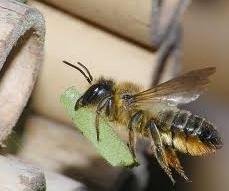About SOLITARY BEES - The lone bees that pollinate
The UK has many species of solitary bee, every one a precious pollinatorClick on a picture in the line below to read about that topic
 SWARMS and PESTS - General help and information about honey bees whether swarming or in residence, and how to find help
SWARMS and PESTS - General help and information about honey bees whether swarming or in residence, and how to find help SOLITARY BEES live and work in single nest cells
It is a surprise to many people that most bees are SOLITARY BEES. The more common images are swarms of honey bees and gangs of bumblebees raising large numbers of offspring in shared nests.
Solitary bees do sting, but the sting is not very powerful and the bees are not aggressive. As they live alone they will never gang up to attack and rarely even bother to guard their own nests.
Solitary bees do sting, but the sting is not very powerful and the bees are not aggressive. As they live alone they will never gang up to attack and rarely even bother to guard their own nests.
What does a Solitary Bee look like?
There are around 250 different species of solitary bee in Britain and a surprising number of these inhabit our gardens.
The Red Mason bees are the most common, nesting in cracks in walls. Tawny Mining bees nest in holes dug underground. Leaf Cutter Bees nest in any hole they can find, above or below ground.
Many species of solitary bees are efficient pollinators, some being specialised in pollinating certain plants.
The Red Mason bees are the most common, nesting in cracks in walls. Tawny Mining bees nest in holes dug underground. Leaf Cutter Bees nest in any hole they can find, above or below ground.
Many species of solitary bees are efficient pollinators, some being specialised in pollinating certain plants.
How to help the Solitary Bee
You can easily help these wonderful insects to survive in and around your garden by making or buying a solitary bee nests. There are many websites that give full instructions or offer a range of nests for sale. Leaving wood trimmings around your garden can also help, as they will burrow inside small hollow branches.
Bumblebee Conservation Trust
You can find out more about our native solitary bees by visiting the Bumblebee Conservation Trust website







